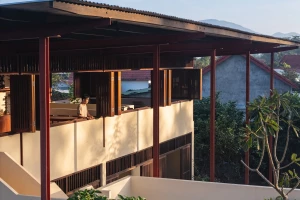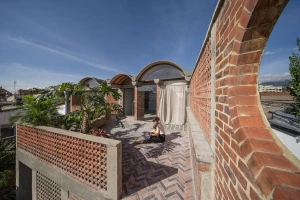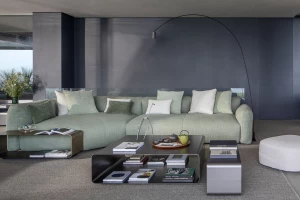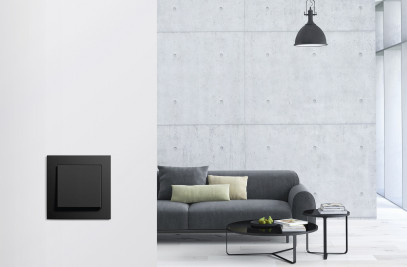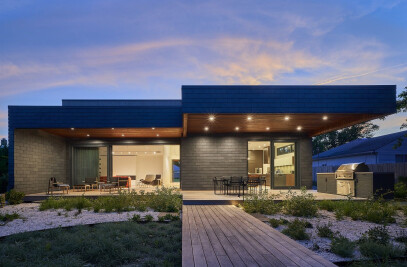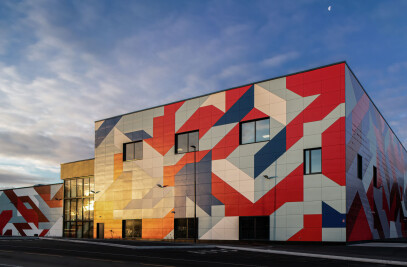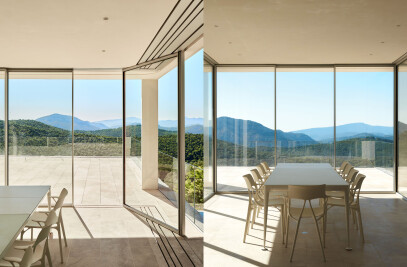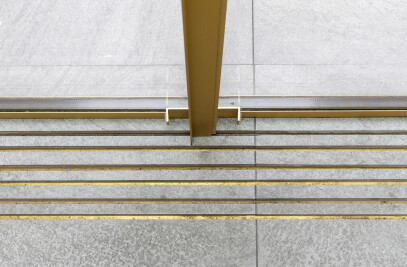Located in the heart of the Triglav National Park in the lush Bohinj Valley of northwestern Slovenia, the newly opened Hotel Bohinj stands as both historical monument and sleek contemporary expression of cutting-edge eco-design. Formerly the Hotel Kompas, built in 1972 and having undergone two awkward and partial renovations since then, the property has been revitalized and reimagined via extensive structural and interior renovations by OFIS Architects in collaboration with energy entrepreneur Damian Merlak. The result is a visually striking building which both organically blends into the surrounding landscape and also expresses the cultural identity of Bohinj through a range of design motifs and vernacular narratives woven throughout the architecture.

The hotel is sited on a raised plateau at the base of the Julian Alps, featuring sweeping views of Lake Bohinj and the church of Janez Krstnik (St. John the Baptist), an important historical site. As part of the renovation, the original building volume was preserved, but encased within a new wooden structural envelope. This covering serves both to seismically upgrade the hotel in a notoriously earthquake-prone region, as well as to forge a new visual identity rooted in landscape. The wooden frame cleverly incorporates practical functions (such as rain gutters, wires, lightning rods, and sustainability interventions) whilst wrapping the building in arresting textural and visual ‘skin’.
Larch wood cladding allows the hotel to blend into the surrounding forest and creates a dialogue between the built and natural environment. The new façade also incorporates balconies for guests and changes the volume’s overall massing, providing structural reinforcement.

A double-height lobby and restaurant extension complements the frame addition. The original hotel’s gabled roofs echoed the profiles of the surrounding mountain tops and inspired the triangulated design of the newer building and its dramatic entrance canopy.

The new hotel features 69 rooms in a variety of layouts, including a presidential suite on the top floor with a view of Mt. Triglav, Slovenia’s highest mountain and the pre-eminent symbol of the Slovene nation. The property also features a café, retro-bistro, wellness centre, conference hall, and wine club and store showcasing the varietals of Slovenian vintners.
The interior of the hotel was meticulously designed to incorporate local crafts and vernacular architectural details and symbols. Custom lighting was created by famed Slovenian lighting specialists Arcadia Lightwear, and is based on energy-saving LED technology. The designers were careful to use intimate, low level lighting which minimizes the hotel’s light pollution and respects its neighbouring nocturnal forest-dwelling creatures and organisms. Sensors ensure that lights are only used when necessary. Table lamps are designed to look like branches, while jagged light installations embedded in wall panels reference the mountainscapes outside and double as artistic focus points for guest rooms.

The same Larch wood that clads the façade is also the main material used for the walls, ceilings, and much of the hotel’s furniture, lending the space a cabin-like feel and a patinated appearance. Side tables and benches made from hewn logs add a rustic feel, and wooden accents such as vases and bowls thematically decorate common areas. White sheepskin rugs and woollen throws give rooms a cozy but modern mountain-chic vibe.
Other details also speak to landscape. Chairs by Donar d.o.o are made of felt produced from recycled plastic bottles. Common area stone floors are the color of the surrounding rocks. Energy rehabilitation was core to the design concept in accordance with the requirements of the National Park. Class A2 was achieved through use of heat pumps, radiant floor convector heating, and centrally controlled thermal regulation.

In addition to the region’s ecology, its culture and folklore are also incorporated into the design. Black stones leading to the entrance and inlaid throughout the lobby floor are a nod to the memory of Mr. Max, the legendary hotel cat from the original building who disappeared to parts unknown after the hotel was closed for renovations. Guests traversing the hotel’s long corridors have an architectonic experience of walking through ‘toplarji’ - double hayracks unique to Slovenia and prominent throughout the Bohinj countryside. These hayracks were traditionally used for drying and storing hay and other foodstuffs as well as providing protection in bad weather, and many are still in use. They were also often artistically designed and hand-crafted and are an important piece of cultural heritage and an iconic example of vernacular architecture. By simulating the experience of hayracks, the hallways remind visitors of toplarji’s cultural significance as well as the need to protect and preserve them as they erode over time, often collapsing on their own.

The architects collaborated with design studio Futro Design to create custom graphics for the space. One design features brightly colored silhouettes of climbers navigating a steep slope, representing the four men who first conquered Mt Triglav in 1778. The motif appears throughout the hotel - on glass surfaces, fabrics, and wall coverings and is intended to symbolize courage and bravery. Another recurring motif incorporates the geometry of the hayracks into an abstract stencil that appears throughout the property on carpets, ceilings, and linens.

Beyond the confines of guests’ rooms, eco-friendly activities are strongly encouraged as part of the experience of visiting the hotel. Hiking, skiing, canoeing and kayaking are available according to season, and the one site wellness centre and spa features a sauna, outdoor whirlpool, and salt-wall relaxation room. The original pool was removed and replaced with an outdoor fireplace and social gathering area, and guests who feel like a dip are encouraged to swim in Lake Bohinj, considered to contain some of the cleanest water in the world due to high flowing river feeds constantly refreshing the flow.

The new Hotel Bohinj stands as an exemplar of innovative design. It is a testament to the rich, multifaceted story that a site is able to tell by preserving but reimagining its prior iterations, as opposed to starting over from scratch. The hotel’s rooms, facilities, and surrounds are harmonized into one thematic concept that seeks to both respect and showcase the beauty of the ancient Triglav National Forest. From this ecologically rooted foundation, local material history and cultural heritage are woven into the story to build a powerful region-specific narrative, giving guests an immersive experience infused with the unique visual and cultural identity of Bohinj.

















